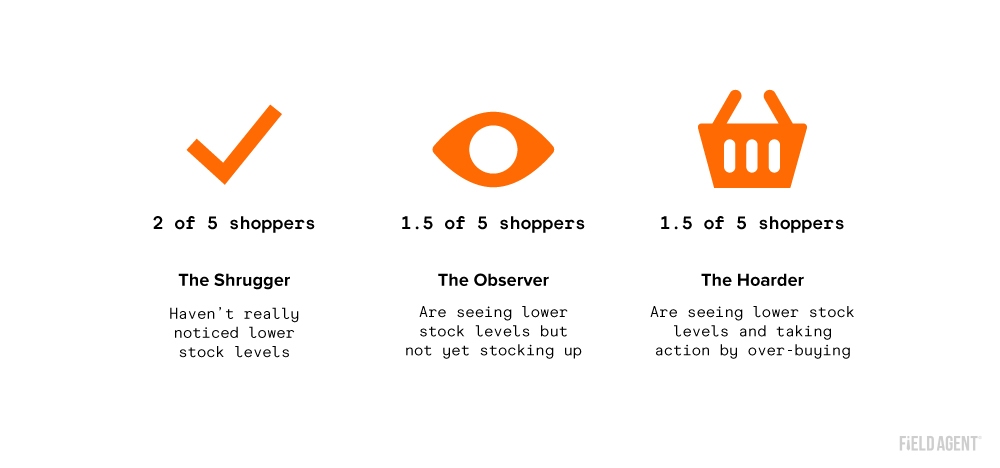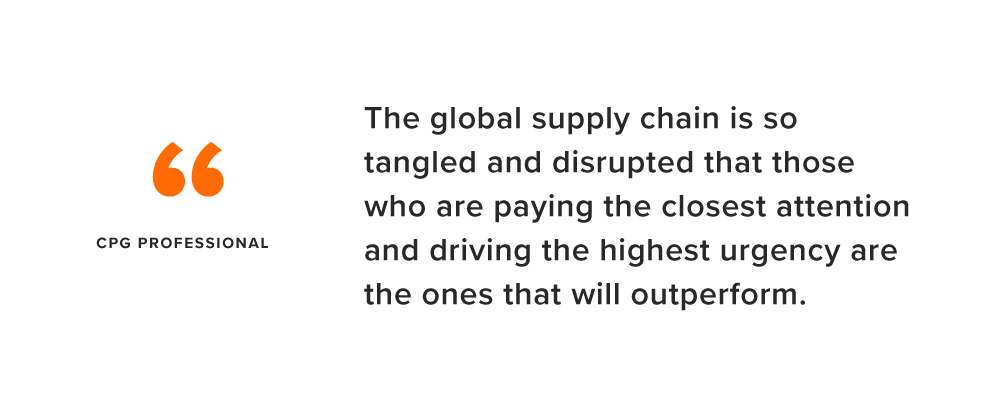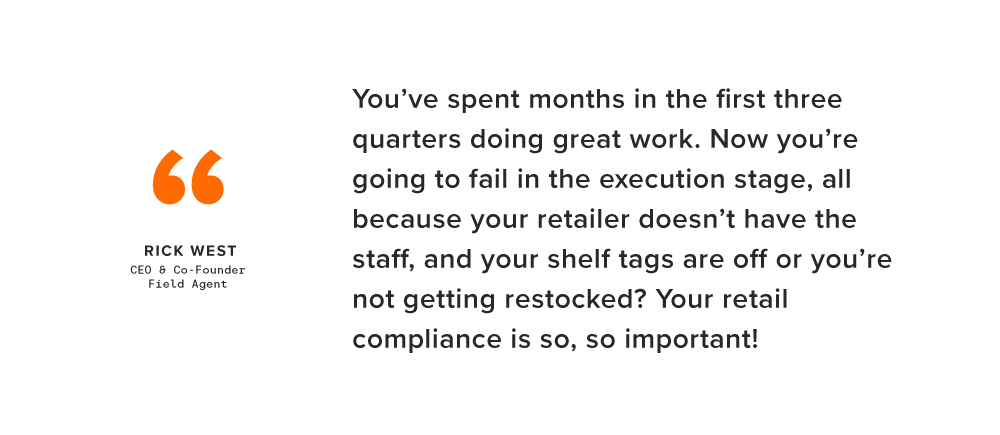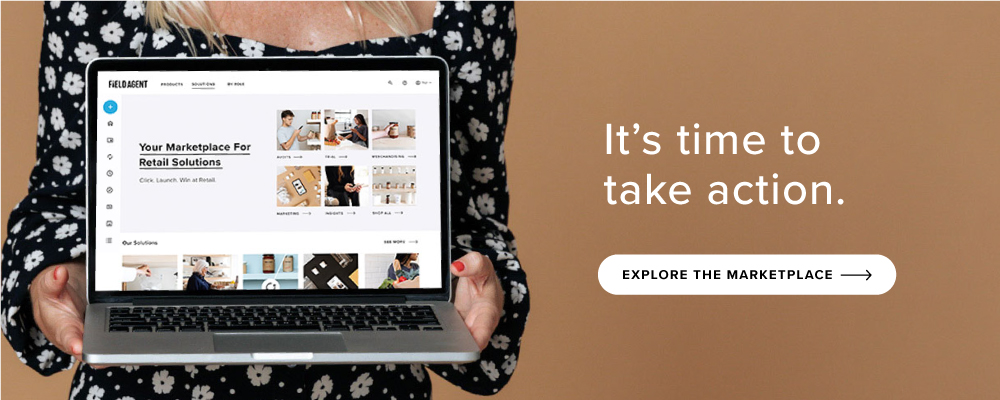
Recapped: 5 Takeaways from Our Webinar on the Supply Chain Crisis
It's no secret. The supply chain is in crisis.
Many aisles contain less stock than normal, as we explored in our last article. And shoppers are changing their behavior accordingly. With the holidays and a new year just around the corner, it's certainly a stressful time to be a CPG professional.
So, what's a brand to do in this challenging retail climate?
This week, Field Agent's co-founder and CEO, Rick West, hosted a webinar to discuss this very question. Drawing from audit and survey data, interviews with CPG professionals, and his 16 years in the packaged goods industry, Rick described the pressing challenges confronting CPG professionals. He also shared practical steps brands can take to grow in an age of supply chain and labor chaos.
Scroll on to read five key takeaways from Rick's talk, and to watch the webinar!
5 Takeaways: "How to Grow a Brand in the Age of Supply Chain & Labor Chaos"
1. Understand your "crisis personas"
Faced with supply chain disruptions and stock shortages, research suggests shoppers are not a monolith. They're responding in a variety of ways to the crisis.
“[There] is not a one-size-fits-all solution. You need to look at your data, and come up with your own personas," West said.
But don't expect all of your personas to be in the same boat.
Indeed, a Field Agent survey of 1,245 shoppers revealed three types of shoppers: "shruggers," "observers," and "hoarders."
 The Shrugger. These shoppers, approximately 2 in 5, haven't yet noticed lower than normal stock levels in stores.
The Shrugger. These shoppers, approximately 2 in 5, haven't yet noticed lower than normal stock levels in stores.
The Observer. Roughly 1.5 of 5 have noticed lower stock levels, but they haven't started stocking up as a result. “They’re a little bit cautious," West said in the webinar.
The Hoarder. “This is the one everyone hears about all the time," said West. "This is the key to the crisis in front of us. They've seen [stock shortages], and they’re taking action by overbuying."
Because of this hoarding, stock levels drop even more, exacerbating existing inventory shortages and further straining supply chains.
West said observers and hoarders, comprising the majority of shoppers right now, present an opportunity for brands. "These are the people looking to switch brands, or who are looking for a new retailer," he said.
The question is: Is your company positioned to make the most of these straying customers, who are forced by out-of-stocks to try new brands or stores?
2. Control the narrative, and provide alternatives
Shoppers are impatient: they expect unlimited availability and lightning-fast delivery. Call it "the Amazon effect." When a choked-up supply chain changes the way you get your product to shoppers, don't expect the delays to fly under the radar. "It's high-stakes," said West.
With so much shopper discontent, West suggested a more direct approach. Through strategic advertising and PR, "you can let your shoppers know that you’re dealing with supply chain issues without ever using the word."
Speak directly to your loyal shoppers, letting them know what to expect as they shop in the coming months, staving off disappointment and frustration.
After all, as West said, “If you’re not controlling the narrative today, somebody’s going to control it for you.”
3. Micromanage the supply chain
“Don’t roll your eyes at the word 'micro-managing',” said West.
One day you're secure in your supply chain, and the next you've lost control of replenishment and inventory. West knows how common this situation is.
"I’ve talked with CPG executives and team leaders, and to a person they say, ‘I was monitoring my supply chain, our safety stock was ok, and I just wasn’t worried about it. Now it’s coming back to bite me...’”
The industry is changing every day, which means you need to pay close attention to your orders, shelves, and forecasts. You need to micro-manage your supply chain.

Retailers need to fill shelves. And if your brand can do it when others can't, you're primed for an opportunity.
"This [supply chain upheaval] isn’t going away anytime soon," West said. "Over-invest in your supply chain.”
4. Generate on-demand sales
When sales are hard to come by and margins are thin, you can't sit around hoping your product will move. It's time, West said, to shift from "sales-hopeful" marketing to "sales-driven" marketing.
Too many brands rely on passive forms of sales promotion during critical and/or chaotic selling seasons. Whether it's in-store demos or display ads, such tactics are, at best, "hopeful that something’s going to happen."
According to West, brands need to "seed" sales in strategic places, especially under present conditions. That is, buy sales to make more sales. This is shifting from sales-hopeful marketing to sales-driven marketing.
Fortunately, tools exist that make such sales-driven marketing a reality.
West continued, "If you explore our marketplace today, you’ll see our Digital Demo program, which turns shoppers into micro-influencers and allows you to provide samples to core consumers."
5. Get serious about retail compliance
Wrong prices. Incorrect planograms. Out-of-stocks. Missing shelf tags, signs, or displays.
These are all-too-common problems inside stores. And current labor shortages mean stores are stretched thin, and in-store execution suffers even more.
Without visibility into stores, brands are in the dark and can only assume everything is going as planned. But it's probably not.
“Don’t expect what you don’t inspect," said West.
Visibility is the key to retail compliance. If you can see it, you can fix it.

You've worked hard for your retail program. But, it can all fall apart if you're not checking in on your retail execution.
This is particularly true now, in an environment of uncertainty and scarcity.
Get serious about retail compliance, and tools like these can help.
Take Action with the Field Agent Marketplace
Field Agent's suite of self-serve, retail solutions is designed to help brands and retailers identify retail problems, drive sales, understand shoppers, and more.
All in one place, with just a few clicks.
Explore the Field Agent Marketplace today, and see for yourself.

